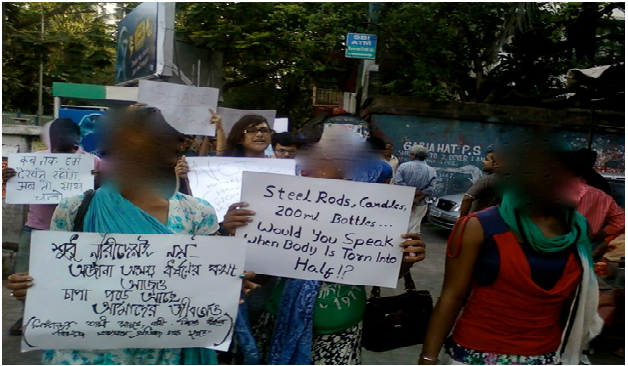Rape in India: A New Low of Brutality

NEW DELHI: April 28, 2016: Jisha, a 30 year old Dalit woman from Perumbavoor, Kerala. Found by her mother with 30 stab wounds, parts of her intestine removed using a sharp object, a head injury, signs of strangulation and torturous assault all over her body.
May 12, 2016: 4 year old girl raped in a transit camp in Chanakyapuri area in New Delhi last week, by a 20 year old man, who allegedly sexually assaulted at least four other girls at the same place.
May 27, 2016: 15 year old girl gang-raped by three men and hung from a tree to ‘make it look like suicide’ in the Bahraich district of Uttar Pradesh.
May 31, 2016: 25-year-old woman from Nepal gang-raped by four men in a moving car in Kolkata.
As appalling as it may be, these are just a few incidents of rape and assault on women in the country in just a month.
The traumatic act of rape is now added to by the torture accompanying it, with the woman’s body becoming an instrument for inflicting pain of the worst kind for personal gratification, or revenge or both.
Almost 90 percent of rapes in India in 2014 were committed by people known to the victims such as relatives, neighbours and employers, government statistics showed.
According to the latest information compiled by The National Crime Records Bureau (NCRB) the number of rapes in the country rose by 9 percent between 2013 and 2014 - with New Delhi reporting 1,813 rapes in 2014, making it the city with the highest number of such cases.
Nearly all of India’s custodial rape — 189 of 197 cases — was reported in Uttar Pradesh, which along with Rajasthan and Madhya Pradesh recorded the highest numbers of alleged gang rapes.
Former Delhi Police Commissioner B S Bassi, had said in a statement that 70 per cent of the perpetrators in rape cases belonged to the age group of 21-35 years.
“Crime-mapping analysis of the city suggested that any woman in a locality is surrounded by between 250 and 400 men who would not think twice before assaulting a woman. Analysis also suggests that 60 to 65 per cent of women victims are between 15-30 years old,” added Bassi.
However, it certainly is time to move past the point of allowing these statistics, though, highly astounding, to be the only area of concern. The sort of pathological sickness exhibited by the men, who commit these brutal acts, often demonstrated by the pathetic condition that they leave the victim in, is an essential element that needs to be addressed.
Another important aspect is the vulnerability of women low on the ladder of India’s caste hierarchy. Like in the case of the monstrous rape and murder of Jisha, a Dalit woman from Kerala, the nation was rife with outrage over the delayed reportage and state intervention concerning her death. Systemic oppression that has been rather intricately woven into our social fabric for ages now is, therefore, yet another facet that determines the manner in which women are violated and subjugated. It denotes how justice often comes late to those who come from the nearly defenseless communities in the country.
Meanwhile, had the repercussions of such acts been deterrent enough, people would have been more fearful of the law and respectful towards women, even.
The lack of swift and serious action against the perpetrators of this crime appears to have contributed to the rise in the number of sexual assault cases and has largely taken away from the legitimacy of the government, local and central.
Owing to limited, often delayed action and several loopholes in our legal system, a heinous perpetrator like the juvenile convicted in the Nirbhaya case was able to walk free in December, 2015. It only took a minor technicality for a person who engaged in a devious crime to escape the law. While one would have liked to believe that the government was actually trying to enforce a more effective plan of action post the brutal gang-rape of Nirbhaya in 2012, the rapid escalation in the number of such cases has only ended up placing the government in the dock, with each case displaying preposterous levels of inhumanity.
Demands for improved women’s rights and security have been around for a long time and will continue to be a part of the mainstream narrative until a woman no longer has to be afraid of being by herself in public spaces, or even private for that matter.
Public outrage to heinous incidents, though, seems to vacillate between the extremes of apathy and high pitched reaction, with the interest coinciding with the media coverage and subsiding accordingly. It is absolutely imperative to sensitize the public to take substantially more proactive steps towards protecting the women of this nation who remain vulnerable not just on the streets of India but in their homes and places of work.



